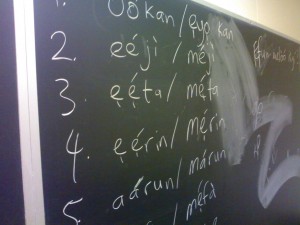By now we can greet. By now we have mastered the basic expressions that express intent.
By now we can ask the questions:
“Kíni orúkọ rẹ?” “Orukọ mi ni…” “Orúkọ ọrẹ mi ni…” “Orúkọ babá mi ni…”
“Kini èyí?” “Èyí ni bàtà.” “Èyí ni asọ.” “Èyí ni gègé.”
By now, we can count from one to ten in Yoruba. By now, we can also express number.
“Ọmọ melòó lo ní?” “Mo ní ọmọ mẹta.”
“Asọ melòó lo ní? “Mo ni asọ méjì.”
“Àburò mélòó lo ní? Mi ò ní àbúrò kankan.”

Or express satisfaction with the teacher’s explanations:
“Sé ó yée yín?”
“Kò yé wa.”
“Ó yé wa.”
On Wednesday, week 4 will be over, and we would have had seven classes so far, each with its own challenges. We have somehow managed to get over the pronunciation challenges, one step at a time. It is not yet uhuru as far as recognizing and being able to correctly pronounce tone marks are concerned. And you can’t blame us. It was a relief for the class to know that there are some authentic speakers of Yoruba in Nigeria today who can’t stand the tone marks nor correctly identify it. The challenge before us is to become better than them. And better than them we shall be. We’re taking it one day at a time.
1
Bola at http://YourWebsite
Tisha, let me ask you something!
(1) When has “ọrẹ” ‘friend’ become re-re? What about the good old do-mi?
(2) Am I right to say that “lo” in “ọmọ melòó lo ní?” ‘how many children do you have?’ is compossed of “ní” and “o”?
(3) Is “kini” not compossed of “kí” and “ní”?
(4) Is “meta” ‘four’ re-re or mi-re?
(5) Would you translate “sé o yé yín?” as ‘do you (plural) understand you (singular)’?
(6) And does “o yé wa” mean ‘we understand you (singular)’?
rofl … I am waiting for my lesson! 😀
Posted at September 15, 2009 on 1:36pm.
2
Kola Tubosun at http://www.ktravula.com
1.òré is do-mi, but when you’re typing on Windows like me, you can’t apply both the tone marks and the sub-dots at the same time, except with a special font which I don’t have here. If you have one, could you kindly send it to me.
2.You’re right.
3. It is.
4. It is mi-re. See answer to question #1.
5. Nope. Literally, it is “Does it understand you (plural)?” but it means “Do you (plural) understand?”
6. Literally, it is “it understands us,” but it means “we understand.”
There you go. Stop rolling on the floor 😉
Posted at September 15, 2009 on 1:50pm.
3
Bola at http://YourWebsite
Still rolling because of (5) and (6). One more question:
(7) Is it not true that “o” re means ‘you (singular)’ while it is “o” mi which means ‘she / he / it’?
I will inform you about a way to combine a tone-mark with a sub-dot on the same vowel … as soon as I can stop rolling … rofl
Posted at September 15, 2009 on 1:56pm.
4
Bola at http://www.tavultesoft.com/keyman/
Try Keyman … or insert > symbol > combining diacritical marks.
Bọ́lá
Posted at September 15, 2009 on 2:12pm.
5
Bimbo at http://YourWebsite
It is fun and happy to be on this site will comment later
Posted at September 15, 2009 on 2:39pm.
6
Temitayo at http://http://bookaholicblog.blogspot.com/
Yoruba teacher per excellence, you are sure making progress… teaching Yoruba kids nowadays sef is trouble let alone Whites. I am really afraid that someday, they will teach us our language…sad one!
Anyways, this teacher reminds me of a fantastic Yoruba teacher I had in JSS1,who used to put the tonal marks as she wrote on the blackboard–I loved her for that. Till date, I write first then go back for the tonal marks.
And I had the awful ones of course…one of the fun times in tonal lesson class remains when a student was told to put the marks on her names, she put it wrongly. The teacher asked the class to pronounce the wrong one…that was the birth of her nickname, till date.
Yoruba classes always revealed real Yorubas, the ajebos and those who try to be ajebos…and again, we had L1 and L2…
Posted at September 16, 2009 on 12:07am.
7
Kola Tubosun at http://www.ktravula.com
Thank you Tayo for your comments.
If you ask me, I don’t think anyone in this class might teach Yoruba in the nearest future. They all come from different majors: Excercise and Wellness, Biology, Speech Communication, MPA, Special Education, German, Political Science, Psychology, and Math-Actverral science (Don’t know what that means). But don’t take my word for it.
I say this only because I am now convinced that it doesn’t fit into the overall aim of any of their majors. It doesn’t look like any one of those guys will like to do a Master in Yoruba studies just for the fun of it. It’s hard enough learning the tones.
But that said, it is not unlikely that many more foreigners will develop interests in the language as time goes on, but this will not be a totally new phenomenon. We have Karin Barber in Birmingham who speaks more fluently than many Yoruba people that I know. There was also Suzanne Wenger who as you know came to become a Yoruba woman and spent the better part of her life promoting Yoruba religion.
As per tone marks, I’ve always loved it. It was always a delight to try to apply tone-marks to words. Nowadays in the age of computers, it is harder because it reduces the speed at which one has to type. Even writing it can become tedious when writing an essay. It is easier on short words and phrases. In any case, it is one of the beauties of Yoruba language.
Thank you again. Ire o.
Posted at September 16, 2009 on 12:18am.